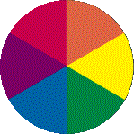EARTH
GUILD
33 Haywood Street
Asheville NC 28801
1-800-327-8448
828-255-7818
fax: 828-255-8593
HOME
PRODUCTS
DYES:
Introduction
 |
DYES: Cautions
We have chosen the dyes we carry with a high priority given to low
risk. But do not ignore the common-sense rules of chemical hygiene.
POISONS
Really toxic substances are rare in studio dyeing (acutely toxic like
gasoline, drain cleaner, bug-spray) but there are some; know them and
treat them with appropriate respect. Among our chemicals, only the two
mordants BLUE VITRIOL and TIN are dangerous at this level.
POWDERS
Donít ingest, donít in-breathe, donít spill, donít raise dust clouds,
donít get on skin; clean up after spills (sweep up, working dry, then
rinse well).
GASES
Fumes from simmering dye-pots can irritate eyes and throats and nasal
membranes; cover pots where possible; donít inhale while youíre looking
in a pot (especially if youíve just uncovered it); work in a well-ventilated
area.
LIQUIDS
Donít drink dye-baths or mordant solutions; donít spill, donít splash;
wipe up promptly (use paper towels and discard them, then rinse thoroughly);
keep off skin, out of eyes; flush skin or eyes with clear running water
if necessary. If hot, be careful of scalding, of fumes and of your heat
source, whether electron- or flame-fed.
IMPLEMENTS
Do not use food containers or stirring or measuring utensils: if you must
use kitchen counters, cover them before beginning and clean COMPLETELY
when you are done.
SAFETY EQUIPMENT
Some dyers do and some donít, but use of rubber gloves, respirator masks,
aprons, is a good practice, at least during the messiest phases.
BE RESPONSIBLE
If pets or small children can enter your work-space be sure they cannot
get to your powders or gases or liquids or heat source.
We're happy to furnish OSHA safety data sheets for all our chemical
dyes, mordants and accessories (they're not available for natural dyestuffs).